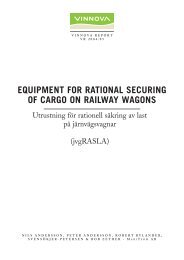Download - Autosim Autosim
Download - Autosim Autosim
Download - Autosim Autosim
You also want an ePaper? Increase the reach of your titles
YUMPU automatically turns print PDFs into web optimized ePapers that Google loves.
CURRENT & FUTURE TECHNOLOGIES IN AUTOMOTIVE ENGINEERING SIMULATION<br />
4.4.7 Mesh Discretisation (Digital model)<br />
4.4.7.1 Mesh Discretisation - Current/Best Practices<br />
It is evident that the size and complexity of material models is continually<br />
increasing with mesh sizes ranging between, but not limited to, 10,000 and<br />
10 Million elements. An issue raised in the AUTOSIM discussions is that<br />
model sizes can be limited according to the available computer resources<br />
on which to run and post-process model predictions. This situation will be<br />
more applicable to small scale businesses operations that do not have the<br />
necessary resources or justification for purchasing large scale computer<br />
resources. However, options do exist for contracting out large model runs to<br />
organisations that do possess extensive hardware facilities. This may be an<br />
attractive option for small scale industries to adopt if they want to develop<br />
and run large scale models but do not have the necessary in house<br />
resources to run large scale models within practical or project timeframes.<br />
As a Best Practice model evaluations should be carried out to assess the<br />
impact that mesh densities have on the predictions from a model. Feedback<br />
from the AUTOSIM discussions indicates that there is neither the available<br />
time nor resources on projects to carry out an evaluation of the mesh<br />
density’s influence on a model’s predictions. Typically the mesh density<br />
used in models is based on past experience and/or an anticipated<br />
understanding of how the model will respond when loaded i.e. increasing<br />
mesh densities in areas where stresses are likely to be highest. Tools are<br />
available in Pre-processing software to carryout automatic objective checks<br />
of mesh quality and structure and the use of these should be considered a<br />
best practice in terms of developing model meshes.<br />
4.4.7.2 Mesh Discretisation – Breakthrough Technologies<br />
The principle of a pre-processing software tool was proposed that includes<br />
features to personalise and store a variety of mesh quality check templates<br />
according to the solving method, customer type or analysis field for which<br />
the model is being developed. It was considered that such a tool could be<br />
used to help in the development of consistent mesh types according to<br />
specific requirements. Along similar lines it was registered in the<br />
discussions that software vendors are already working on the development<br />
of mesh dependent solvers, which adapt solver methods according to mesh<br />
types and structures in order to optimise model run times.<br />
Because of the lack of mesh optimisation that is carried out it is expected<br />
that a way forward to resolve this issue would be the development of<br />
intelligent mesh adaptation tools that are able to evaluate mesh<br />
discretisation errors and automatically improve critical mesh areas based on<br />
past predictions.<br />
44 |<br />
SIXTH FRAMEWORK PROGRAMME PRIORITY [6.2] [SUSTAINABLE SURFACE TRANSPORT]<br />
012497 AUTOSIM
















